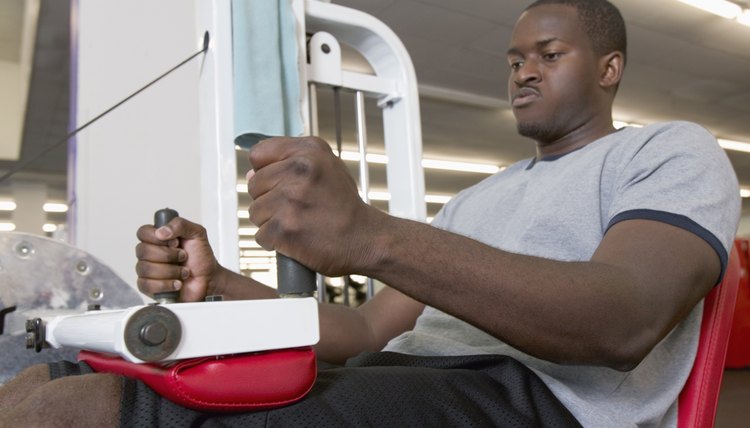Circuit Training With Weight Machines

When properly performed and sequenced, a continuous circuit training protocol at a sufficient intensity can elicit a satisfactory cardiorespiratory response. A properly designed circuit training exercise program will improve or help maintain your muscular fitness and cardiorespiratory fitness levels. Circuit training involves limited rest periods, keeping your heart rate elevated. A good circuit training program will burn more calories than traditional weight training, and thus be beneficial to a weight loss program.
Significance
You have probably been around the gym enough to notice most people resting on equipment after they finish their sets. The American College of Sports Medicine recommends weight training two to three days a week. The resistance, for weight loss and toning, should be set so you are able to do 15 or more repetitions. Over the years, individuals typically have exercised a particular muscle group for two to three sets, resting in between each set. Circuit training, however, involves using high repetitions, rotating eight to 12 different strength training exercises, and resting minimally between each exercise. This process of moving from machine to machine, with little rest, keeps your heart rate higher, burns more calories and has been shown to greatly improve cardiovascular endurance and muscle tone.
Planning
Work with an exercise professional to figure out an appropriate weight to use on each machine. The exerciser should use a weight which becomes difficult to lift after a certain amount of reps. Work with a professional to decide on the eight to 12 exercises that you will use in your circuit program. It is best to use large, compound muscle group movements, such as the chest press, lat pull and leg press. Exercises that work more than one muscle group at a time will burn more calories.
The Process
Always properly warm up before starting your circuit. Use a cardiovascular machine for two to five minutes, and also consider some type of upper body activity, including stretching. Begin your circuit training with the larger muscle groups, such as your chest, back and legs. Complete 12 or more repetitions on each exercise. Move to the next machine without resting. When you finish your repetitions on each machine, you should feel like you completed as many reps as you possibly could without resting or setting the weight down. Keep moving through the machines until you complete all the exercises. As you get stronger, and your endurance improves, consider increasing weights on each machine, and doing more than one rotation through the exercises.
Considerations
Before you choose the eight to 12 exercises for your workout, consider any particular muscle groups you want to focus on. If you want to improve the tone of your inner and outer thighs, consider adding machines that work those areas. Include abdominal and lower back exercises in your routine, as those muscle groups improve your posture and reduce your risk of back problems. Stay hydrated. Keep a bottle of water with you when you move through your circuit. If at any time you feel dizzy or experience any warning signs -- such as chest pain or shortness of breath -- discontinue your exercise immediately. Let a member of your fitness center's staff know. Talk with you doctor before beginning any type of exercise program.
Potential
A good circuit training program can help you improve your overall cardiovascular and muscular endurance. It also helps you burn more calories. Once you get accustomed to your circuit training program, you will find that you can move through it quickly, and this means you will be able to accomplish a great deal in a minimal amount of time. If you are worried about sticking with the program, ask a friend to join you. Working out with a friend has the potential to make your training program more enjoyable and gives you an accountability partner.
References
Writer Bio
Paul Elsass started writing in 1986. He has written articles for the Clinical Exercise Physiology Association and multiple medical-fitness centers. Elsass has certifications through the American College of Sports Medicine and the American Council on Exercise. He holds a Bachelor of Science in Kinesiology from the University of Texas and a Master of Science in Management from Northern Arizona University.
